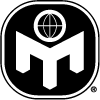What do you think about when you think about interconnections? Among other different things, Interconnections is a triptych mosaic mural located inside the Lenexa City Center Library, Lenexa, KS. This library is new to the Johnson County Library system. It had held a ribbon-cutting ceremony as recently as June 2nd, 2019, when tours were given to introduce the public to the new building, as well as to allow visitors to gaze upward upon the new public art project, Interconnections, which was designed by award-winning artist Stephen T. Johnson.
Editor’s note: When this library reopens on June 15th, spend some time with Interconnections if you can and learn about its little passages of colorful, harmonious interconnections.
Q-1/ Why is the essence of your triptych Interconnections like an alphabet?
Stephen/ Concert halls, art museums, and public libraries invite us to explore ideas and the interconnections they evoke through sounds, colors, and language. We rearrange the notes of a scale to generate musical compositions, we mix the colors of a rainbow to create visual works of art, and we reorder the letters of an alphabet to form words and texts.
As with a triplet of stained glass windows or three lines of a Haiku, Interconnections is a triptych that celebrates the twenty-six letters of the English alphabet through a profusion of typographic fonts, both uppercase and lowercase, intermixed with images from my books — Alphabet City, Alphabet School, and A is for Art: An Abstract Alphabet.
Reading from left to right, the first panel celebrates the letters A to I, the second panel J to Q, and the third panel R to Z. The goal of Interconnections is to inspire visitors to the library to view our world in a fresh and playful way, and in so doing, discover for themselves juxtapositions of scale, color harmonies, rhythms in surface textures, and joy in what may seem unremarkable or ordinary, by transcending the mundane and unearthing its hidden beauty.
Q-2/ How did you begin to think about this creation as a conceptual idea?
Stephen/ After being awarded the commission, I had constructive discussions with members of the public art commission, particularly Christopher Leitch (also a staff member of the library), who encouraged me to push my concept for the designated three large vertical spaces to include references to my various children’s books. It was clear to me relatively quickly thereafter, that I should consider using my three published alphabet books — Alphabet City, Alphabet School, and A is for Art: An Abstract Alphabet as a source of inspiration for the murals. Paired with my love for abstract collage, which connects and contrasts edges, patterns, colors, shapes and imagery, this was the perfect medium to introduce my various typography binding the three designs in both a visual and conceptual manner.
Q-3/ Which particular skills did you apply/use with Interconnections?
Stephen/ The designs for these murals were constructed digitally beginning with physical collage (found paper sources like posters, magazine advertisements, old books, and the like), that I would scan into the computer and with Photoshop, change the size and colors of shapes and imagery. I also scanned various pages from my alphabet books and chose the letters that would work best within the overall design being mindful that they would be translated into glass mosaics for the final artwork.
Q-4/ What were the other helpful artistic resources you drew from? (Like, emotions, materials, tools, your father?)
Stephen/ My love of abstract collage that has a heavy typographical component came from several remnants of political posters that my father (Ted Johnson a Mensa member since the early 1990’s) saved from our years living in Bordeaux, France in the 1970’s. I referred to these posters for the design of Interconnections. My propensity for incorporating bright primary colors intermixed with pink, green and black create a dense and vibrant impact. This was made possible by the extraordinary artistic work of Franz Mayer of Munich. Beginning with the interpretation of my design, to the shipping and eventual installation, Franz Mayer translated my designs into gorgeous mosaics. Working with them was a joy and as an artist that generally works unassisted, I greatly enjoy the collaborative nature of public art which includes working with project managers, architects, consultants, local representatives, interior designers, and contractors that together, produce a mutually beneficial and memorable experience for all.
Other Suggested Online Resources:
Family Art Guide – https://www.jocolibrary.org/sites/default/files/lx_familyartguide.pdf
Library lessons — https://kansasalumnimagazine.org/issue-5-2019/stephen-johnson-library-lessons/
Lenexa City Center Library, Lenexa, KS — https://stephentjohnson.com/#/library/



